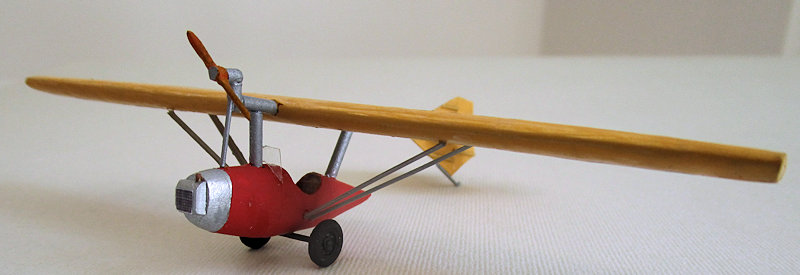
| KIT #: | |
| PRICE: | $ |
| DECALS: | Home made |
| REVIEWER: | Chris Peachment |
| NOTES: | Made from 10 and 20 thou plastic card, rod and strut. |

| HISTORY |
Willy Messerschmitt had already made a few light
aircraft such as the M 17 and M 23, which proved popular with the growing sport
flying market, when in 1932 he presented the M 33, a "Volksflugzeug", at the Luftsportausstellung show in Berlin, where it was shown on the BFW stand. The
idea was that it would be cheap and simple and would allow e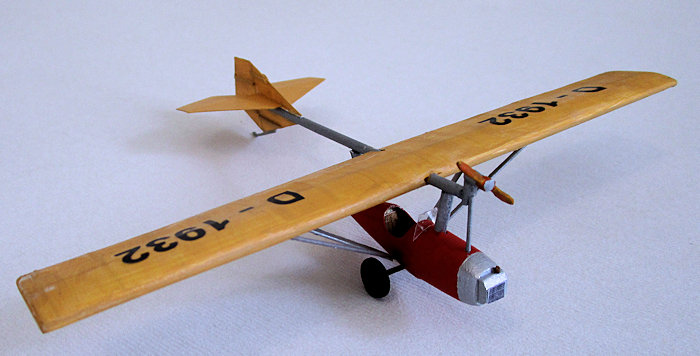 veryone to fly, much
as the Volkswagen promised the idea that all families should have a cheap and
workable car.
veryone to fly, much
as the Volkswagen promised the idea that all families should have a cheap and
workable car.
As you can see, the water cooled engine sat in the nose, driving a high propeller via a shaft and gearbox. One glance at the thing can tell you that it would have been viable and the design pre-figures today microlight market. Alas, the global economic crisis kicked in at the time and the aircraft never took off commercially.
I first came across this dinky little thing while browsing a paper modelling site, something which is always worth doing as it yields not only good aviation history, but also plans which can often be downloaded free. For reasons best known to themselves, paper modellers tend to model in either 1/33 or 1/66 scale. But the plans can easily be rescaled to Gentleman's Scale and printed out. Or 1/48 if you must.
| CONSTRUCTION |
As usual I began with might have proved the trickiest
part of the build, which in this case was the fuselage. Obviously one drawback
to paper modelling is that it finds compound curves hard to replicate and so
tends to rely on multiple bands of paper for a fuselage such as this. Careful
study of the photos shows where the fuselage is flat, or has the subtle curves
of the panel beater's art. I built the pod out of thin 10 thou card sections,
buttressing each one with interior formers of thicker card to which they could
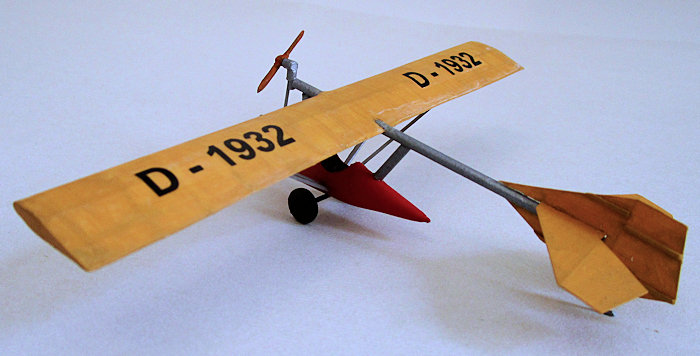 be glued. Smears of filler hid the joins, and rounded the whole thing out again
to the teardrop shape required. The nose is carved from solid block.
be glued. Smears of filler hid the joins, and rounded the whole thing out again
to the teardrop shape required. The nose is carved from solid block.
There is a basic seat and instrument panel inside, all in wood with some leather for the seat, and an aluminium stick.
After that it is all plain sailing. The wing is one piece of 10 thou card, folded over at the leading edge, but not before the ribs are scribed inside with a steel rule and biro, and a spar placed at about 1/3 of the chord, back from the leading edge.
The main longitudinal spar carrying the tail goes through the centre of the wing, and the holes for it should be cut gingerly. The tail is thin card, sanded at leading and trailing edges. Note that the fin and rudder has some strengthening ribs.
After that, it is just a question of measuring strut lengths and glueing it all together.
| COLORS & MARKINGS |
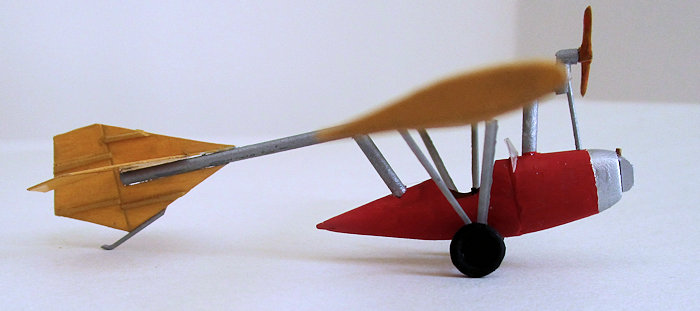 It is best to paint all the major parts before
assembling. The fuselage is Carmine Red, and the wing is Yellow Ochre, both from
the Vallejo acrylics range. I rubbed a little dark brown pastel dust into the
wing, just to reduce its glow a little, but also to point up the ribs. The wing
markings are home made decals, done in Gill Sans font, which was popular in the
1930s.
It is best to paint all the major parts before
assembling. The fuselage is Carmine Red, and the wing is Yellow Ochre, both from
the Vallejo acrylics range. I rubbed a little dark brown pastel dust into the
wing, just to reduce its glow a little, but also to point up the ribs. The wing
markings are home made decals, done in Gill Sans font, which was popular in the
1930s.
The nose mounted radiator is sanded down from a block
of thick card. The nose grille is made from some very small mesh. If you half
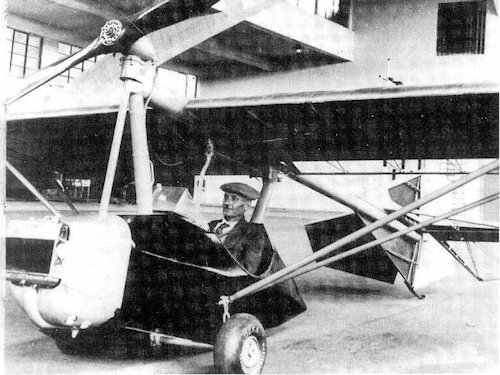 close your eyes and squint at it in a bright light, you can see a tiny filler
cap, made from rod, and painted brass. Wheels came from the big Bag of Dead
Wheels, mounted on a simple axle.
close your eyes and squint at it in a bright light, you can see a tiny filler
cap, made from rod, and painted brass. Wheels came from the big Bag of Dead
Wheels, mounted on a simple axle.
Finally, the smallest propeller known to aviation was cut down from an already very small propeller. And mounted at ten to four.
I wish that my figure painting skills were better. In fact I wish I had figure painting skills at all. Because in one period photo of the aircraft, there is a man sitting in the cockpit, with smart sports jacket, collar and tie, and a flat cap on his head. He has a distant look on his face which looks vaguely familiar. He also has a toothbrush moustache under his nose. Could it be...?
| CONCLUSIONS |
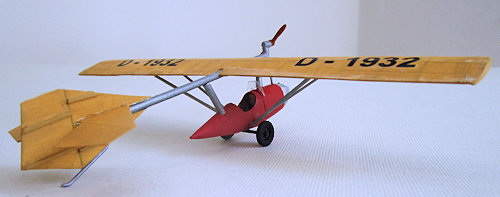 There you have a very nice little example of pre-war
sport flying. It is a shame that the design coincided with an economic crash,
because it might have been very successful. As for Willy Messerschmitt, he went
on to lesser things.
There you have a very nice little example of pre-war
sport flying. It is a shame that the design coincided with an economic crash,
because it might have been very successful. As for Willy Messerschmitt, he went
on to lesser things.
| REFERENCES |
http://www.rc-network.de/forum/showthread.php/60634-Messerschmitt-M33
http://www.kartonbau.de/forum/messerschmitt-m-33-new-releases/board3-aviation/t9355-f75/
http://www.papermodelers.com/forum/aviation/27377-forgotten-messerschmitt-m33-1-72-a.html
Chris Peachment
March 2016
Copyright ModelingMadness.com
If you would like your product reviewed fairly and fairly quickly, please contact the editor or see other details in the Note to Contributors.